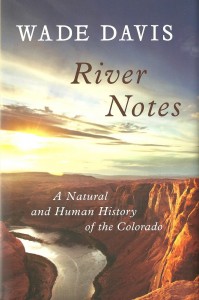Book Review
Wade Davis’s River Notes opens with Aldo Leopold in flat water: having just finished his management plan for the Grand Canyon, the conservationist and his brother float the Colorado River Delta in a canoe. Among its marshes and ponds, lagoons and jungles, vaquita porpoises and corvinas, Leopold moves with the river as it decides “which of a hundred green lagoons offered the most pleasant and least speedy path to the gulf.” Limited by neither time nor space, the river “traveled them all, and so did we” and “got lost and was glad of it and so were we.”
Davis contrasts the Colorado River of 1922 with the delta today:
Today the gallery forests of cottonwood and willow are a shadow of memory, displaced by thickets of tamarisk and arrowweed, invasive species capable of surviving in soils poisoned by salt.
A saline slurry of wastewater passes through rusted culverts and contaminated land, finally reaching the gulf as “a river only in name.” The upstream river is equally disappointing, plugged with twenty-five dams speckled with houseboats and Jet Skis. Davis’s human history chronicles the Colorado’s fall: from its historical headwaters of indigenous peoples, through Spaniards and Mormons, through dam builders and tourists, as it becomes less a river with each rapid.
The current Colorado could not be further from Leopold’s delta, not just the result of a century of transformation, but because the river is seen through second-hand descriptions. Instead of walking the soils of the Salton Sea, or reading the geology of the canyon walls with Davis’s own eyes, the text meanders through a series of well-worn names and images. Davis invokes Edward Abbey and conjures Thoreau, Whitman, Powell, Stegner, Brower. The good and the evil fall along clean lines: indigenous people and a world without dams on one side, Euro-American pillagers on the other. Alongside the elders of the environmental movement, Davis longs for a world in which humans were better and the world more pristine.
I thus enter the second third of the book with something similar to the fear Davis expresses before stepping into his raft in the Grand Canyon:
I felt on that first morning an odd mix of exhilaration and trepidation, not for fear of the notorious rapids, but rather out of concern that this most legendary of white-water adventures might somehow disappoint.
Yet the second two thirds of the book do what the first does not. They navigate rapids, discover shrines in canyon walls, meander in and out of Powell’s journals, and point toward the central question of the book: Could a journey down a river that had by any definition been plundered and violated still inspire?
When Davis drops into the great Lava Rapid, he describes a canyon so impressive it makes no difference if twenty-seven thousand people a year share the same experience on daily flows timed by dams. Looking down on the rapid, Davis writes, “The fate of the Colorado and the Grand Canyon was the last thing on my mind,” and it is this release from the predetermined story of the Colorado’s demise that redeems the book.
Davis’s personal story, on a river that obviously still inspires him, makes it possible to again read Stegner’s phrase “the geography of hope” and consider a new interpretation. The geography of hope represents “the spirit of a free and independent people” who consider “despair an insult to the imagination.” Davis asks the American people to shatter our way of thinking and implores us to include plants and animals, rivers and lakes, soil and sky in our sense of prosperity. Only by doing so, he writes, does Leopold’s song of the free and the brave become a hymn. River Notes sings not because of its recounting of geology and history with words that have been said many times before, but because of its personal song to a river that, despite all, still inspires. Perhaps it is not always enough to drive to the edge of wilderness and look in, to know plants by their image in a guidebook, or geologic formations through a book, or an ethic through our elders. Perhaps we must also sing our experience.
About the Reviewer
Teresa Cohn is a geographer of the American West, and an instructor in the Department of Earth Sciences at Montana State University and the Environmental Humanities Program at the University of Utah.
